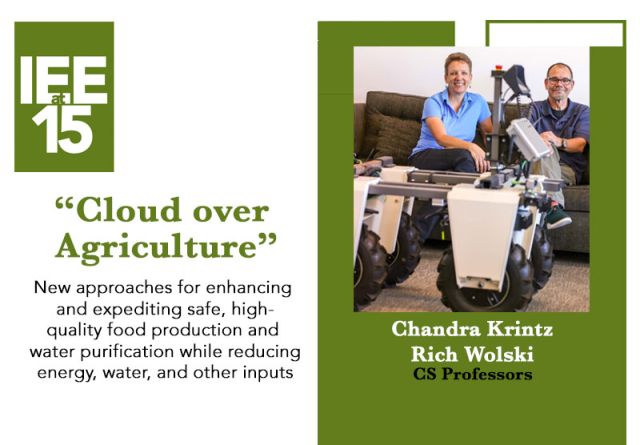Chandra Krintz & Rich Wolski | "IEE at 15 'Cloud over Agriculture'"
“A big part of what we do is to bring the very cutting edge of technology to people who have not previously had access to it in a way they can use” – CS Professors Rich Wolski & Chandra Krintz
Excerpt from the COE/CLS Convergence magazine (Summer 2024) article “The Institute for Energy Efficiency (IEE) at 15” (pgs. 12-17)
Since it was established in 2008, the Institute for Energy Efficiency (IEE) at UC Santa Barbara has become a juggernaut of collaborative interdisciplinary innovation. The nearly one hundred current affiliated faculty and their predecessors, in disciplines ranging from economics and electrical engineering to physics, biochemistry, materials, and environmental policy, have made dozens of groundbreaking discoveries and developed important technologies and strategies related to three interdisciplinary pillars, or themes: Smart Societal Infrastructure (SSI), Energy Efficient Computing and Communications (EECC), and the Food-Energy-Water Nexus (FEWN). The full article offers a glimpse of some of the much larger universe of research being undertaken by IEE affiliates that include Krintz and Wolski.

Cloud over Agriculture Computer science (CS) professors Chandra Krintz and Rich Wolski both had academic careers at UCSB, left to start their own respective tech companies in the cloud space when it was just getting started, then returned to UCSB. They conduct some of their research within IEE’s Food-Energy-Water Nexus focus, which has the mission of enabling renewable energy to account for fifty percent of U.S. energy production by 2030 and one hundred percent by 2050.
To that end, IEE researchers develop novel techniques and approaches for enhancing and expediting safe, high-quality food production and water purification while reducing energy, water, and other inputs.
Seeing an opportunity to apply cloud computing innovations focused on e-commerce to what Wolski refers to as “a whole raft of societal problems that were not benefiting from this amazing technology revolution,” he and Krintz joined forces. They created a lab, and a project called SmartFarm, aimed at “allowing technology to benefit some underserved parts of society,” Krintz says. “Rural communities and agriculture were prime application domains that were so in need of some of these advances that would enable them to use cell phones, data analytics, and other technologies to enhance their agricultural efficiency.”
SmartFarm became, Wolski says, “a guiding framework for everything we do today,” all of which relates to the IEE mission of enhancing efficiency to protect and preserve resources. They work along three main thrusts: agriculture, ecology, and climate change. “We have found that all of them can benefit from the same kind of unified approach to adopting cloud-based technological inputs that have revolutionized e-commerce, social networking, and entertainment,” Wolski says.
Krintz and Wolski routinely collaborate with farming practitioners, literally in the field. “It is unusual for computer scientists to work with professional growers as research collaborators,” Wolski points out, “but that is how we know our research will have an immediate impact.”
Krintz adds, “A big part of what we do is to bring the very cutting edge of technology to people who could not previously access it in a way they can use. Growers manage their crops by hand, relying on a lifetime of accumulated expertise. They say I’m going to spray on Tuesday, and now we can say, ‘Here’s how much moisture is in the soil now. Do you [still] want to spray on Tuesday, or maybe on Friday, when conditions will be more favorable?”
Data analysis is a crucial SmartFarm input. Krintz and Wolski have worked with one consultant in California’s Central Valley, a retired farmer who has a business helping growers with their irrigation strategies. His practice has been based on using a great deal of instrumentation and some chemical assays to assess the soil composition of a given plot, and then to prescribe various watering strategies.
“The issue we saw was that, while he was using data to inform his recommendations, he could use it in a better, more scientifically defensible way,” Wolski explains. “We built a service and then back-tested it against about twenty-five years of his analysis, and the benefits to be gained were astonishing. It’s an example of someone who was highly competent, but not necessarily competent with the technology. The impact was instantaneous, and now there’s a bunch of people who have much better irrigation scheduling today because of a system that is rigorous as opposed to ad hoc.”
In this and other work that Krintz and Wolski did with the consultant, they had to be sure, Wolski says, “that our suggestions fit his mental model, or he wouldn’t trust them. This is his living, right? We were able to do that and help him improve his outcomes.”
Krintz says that they would have failed had they simply said, “Listen to us; here is how to improve your efficiency. You should do this.” Rather, it’s important to start where people are, communicate in language they understand, respect what they are already doing, and “make it clear that their interests are at the center of our interests. We’re learning how to cross these tremendous communication gaps and experience gaps to bring data science and data-driven thinking to rural communities, in particular. It’s extremely challenging; it requires new training and new thinking, and that’s part of why we do this research.”
Ahead for Krintz and Wolski is further development of the robot they created and named Gort (after the humanoid character designed to protect the universe in the 1951 film The Day the Earth Stood Still ). The original Gort had a laser as a weapon; this latter-day version incorporates a laser to use as a networking technology for gathering and distributing data, that could also power batteries. Gort has not yet been put to work in agricultural fields. That, as Krintz and Wolski say, “is on the horizon.”